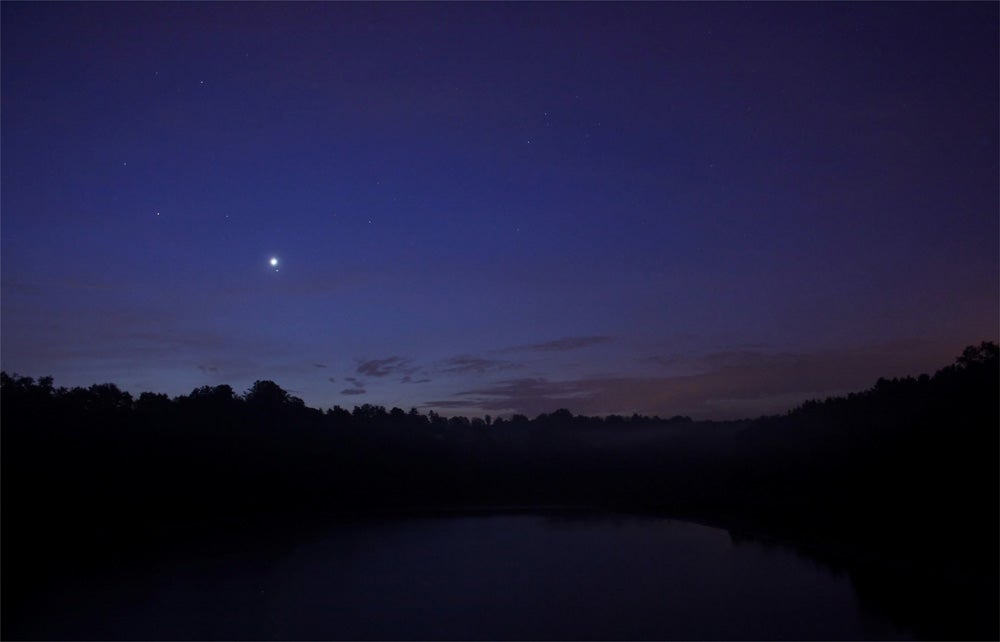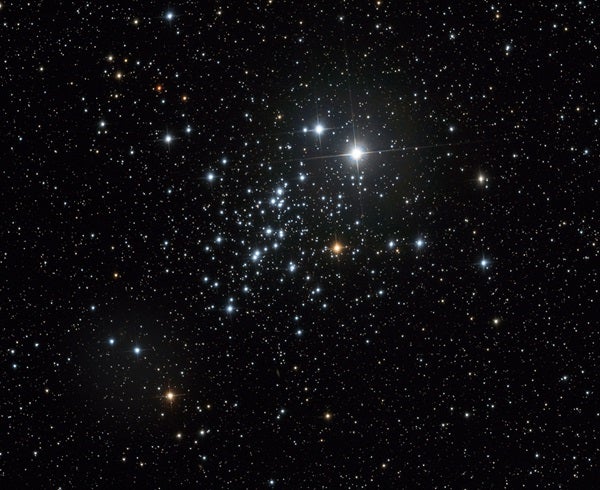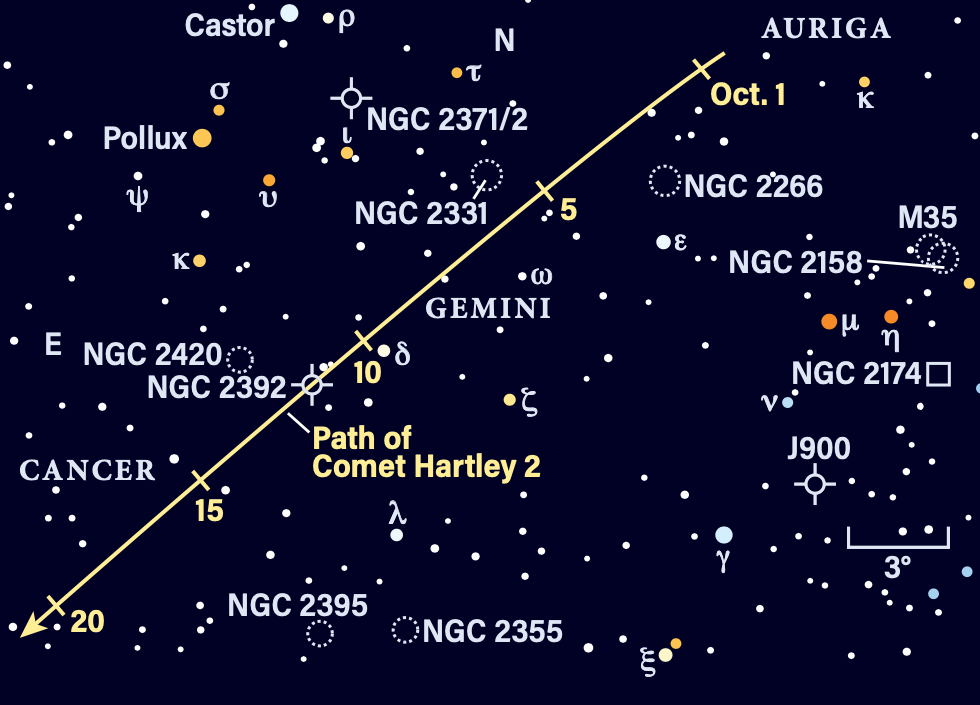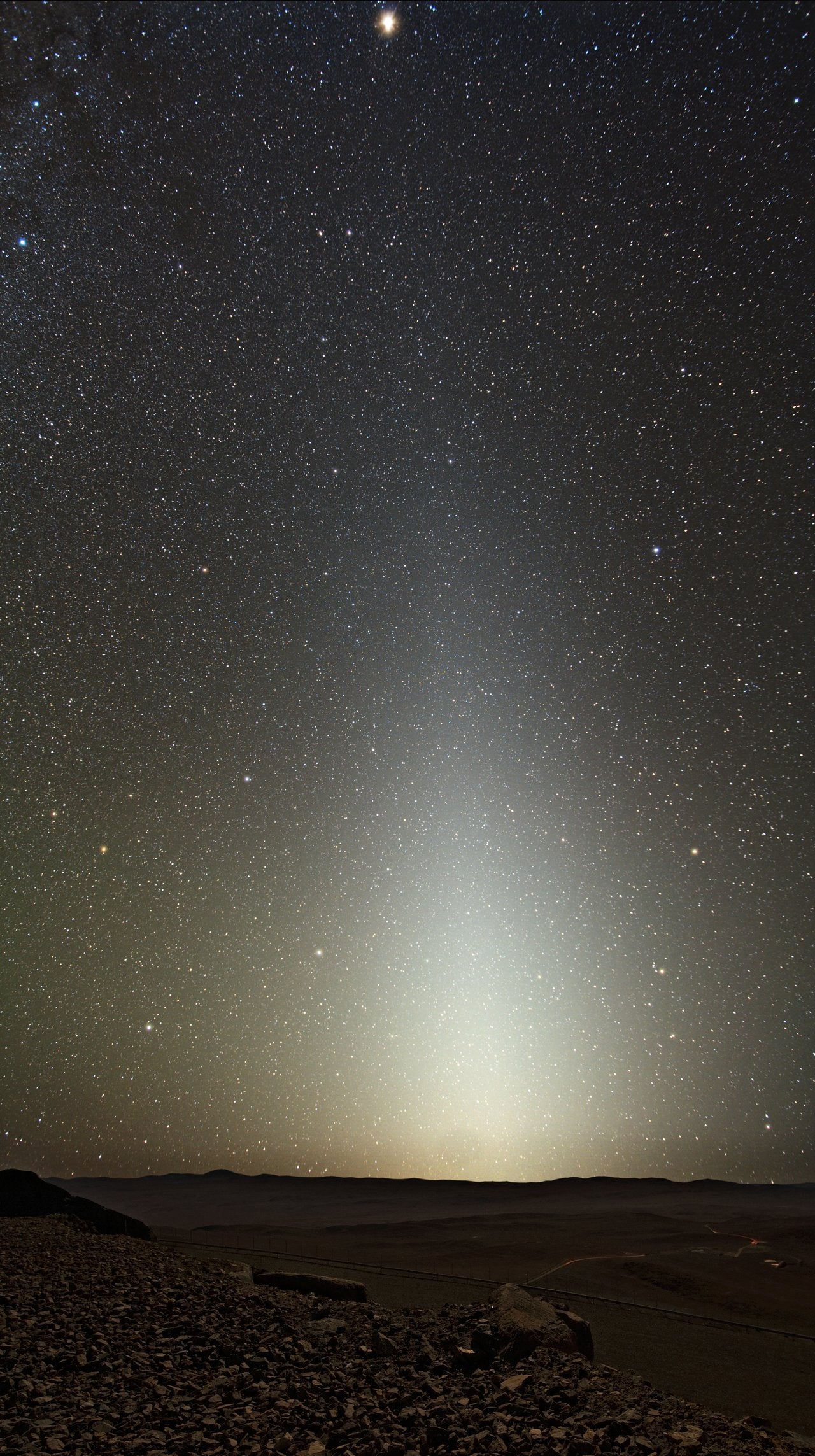
Friday, October 6
Last Quarter Moon occurs at 9:48 A.M. EDT. During this phase, our satellite rises late and dominates the morning sky, leaving the evening dark for some deep-sky observing. The galaxy group we’re going to aim for is in Canes Venatici, which is setting as the Sun sinks below the horizon and best for early-evening observing before it gets too low. Admittedly this target is best for large-scope (10 inches or more) observers or astrophotographers, but even if you have a slightly smaller scope, dark skies may aid your search, so see if you can find our targets.
About an hour after sunset, look northwest, where you’ll spot the Big Dipper low in the sky. The Dipper’s long handle (in fact the tail of Ursa Major) arcs above the faint constellation Canes Venatici the Hunting Dogs, where we’re looking for magnitude 11.1 galaxy NGC 5353, which is part of Hickson Compact Galaxy Group 68. It’s located 9.2° south-southeast of Alkaid, the last star in the Big Dipper’s handle.
Just north of NGC 5353, so close the two smudges may appear to your eye to be touching, is magnitude 11.4 NGC 5354. About 5′ north of NGC 5353 is magnitude 11.5 NGC 5350, which lies near a bright 6th-magnitude orange field star, HD 121197.
There are even more members to this group you can try for if you’re ambitious: NGC 5358 sits about 6.5′ east of NGC 5353; you may or may not be able to pick it up at magnitude 14.6. Slightly easier (but still challenging) will be magnitude 13.2 NGC 5355, about 5′ northeast of NGC 5353.
Small-scope users, we won’t leave you out: Canes Venatici is also home to numerous other — and brighter — targets, including the fabulous globular cluster M3 near the constellation’s border with Boötes. Look about 11.7° northwest of bright Arcturus in Boötes to find 6th-magnitude M3, an ancient ball of some half a million stars covering nearly 20′ of sky.
Sunrise: 7:01 A.M.
Sunset: 6:34 P.M.
Moonrise: 11:50 P.M.
Moonset: 2:55 P.M.
Moon Phase: Waning crescent (49%)
*Times for sunrise, sunset, moonrise, and moonset are given in local time from 40° N 90° W. The Moon’s illumination is given at 12 P.M. local time from the same location.
Saturday, October 7
The winter constellation Orion is now well above the horizon in the hours before dawn. The Hunter’s belt is one of the most recognizable patterns of stars in the sky, formed by (from west to east) Mintaka, Alnilam, and Alnitak.
Let’s start with Mintaka, a magnitude 2.3 star that lies just ¼° south of the celestial equator. Through a telescope, you can spot its multiple nature — the brighter primary is flanked by a 7th-magnitude companion star about 1′ away. (The system is more complex still, with many other components, though they can’t be easily seen in backyard scopes — if at all.)
Moving east (toward the ground as the constellation rises), we land on Alnilam. At magnitude 1.7, it’s the brightest of the three Belt stars and is also the farthest from Earth. Astronomers estimate this luminous star is about 4 million years old and already running out of hydrogen to fuse into helium, as hot, massive stars burn so brightly that they exhaust their fuel supplies much more quickly than smaller, cooler Sun-like stars.
At the eastern end of the belt is Alnitak, which matches Alnilam’s magnitude of 1.7. According to the late Jim Kaler, Alnitak is the brightest O-class star in the sky. It lies just ½° north of the famous Horsehead Nebula, which is formed not by glowing gas but by a dark cloud that blocks out the light of the nebula IC 434 behind it. Swing your telescope up and see how much detail you can discern — does the Horsehead indeed look like a horse’s head, or more of an oval-shaped smudge against the brighter glow? You might have the most luck by sliding your field of view just slightly to put blazing Alnitak out of frame.
Sunrise: 7:02 A.M.
Sunset: 6:33 P.M.
Moonrise: —
Moonset: 3:37 P.M.
Moon Phase: Waning crescent (39%)

Sunday, October 8
Cassiopeia is a circumpolar constellation, meaning it appears to circle around the North Star in the Northern Hemisphere. A few hours after dark, the Queen is high in the northern sky, offering excellent views of the many objects she contains, including our goal for tonight: NGC 457, also called the Owl Cluster.
This open cluster of nearly 100 young stars stretches about 13′ on the sky and is an excellent target for binoculars or any small scope, making it extremely beginner-friendly. Glowing at 6th magnitude, you’ll find the grouping some 2° southwest of magnitude 2.7 Ruchbah (Delta [δ] Cassiopeiae).
Once you spot NGC 457, you’ll likely immediately see why it’s got its name: The cluster’s stars give it the appearance of an owl in flight, with two bright eyes to mark its head and its wings outstretched. The brighter eye is 5th-magnitude Phi (ϕ) Cassiopeiae, while the slightly fainter one is 7th-magnitude HD 7902. They are not brighter because they are more luminous than the rest of the cluster’s stars, however — instead, neither lies at the distance of the cluster, but both sit in the foreground from our point of view.
Sunrise: 7:03 A.M.
Sunset: 6:31 P.M.
Moonrise: 12:52 A.M.
Moonset: 4:10 P.M.
Moon Phase: Waning crescent (30%)
Monday, October 9
The Moon reaches apogee, the farthest point from Earth in its orbit, late tonight at 11:42 P.M. EDT. At that time, our satellite will sit 251,920 miles (405,426 kilometers) away.
The mighty gas giant Jupiter is nearing opposition and visible most of the night, rising shortly after 8 P.M. local daylight time. Now 49″ across and magnitude –2.9, it’s impossible to miss in the constellation Aries, whose own stars pale in comparison.
Take out your telescope tonight to observe the planet’s four largest moons. Io sits alone to the planet’s west, while Europa is immediately east of the disk, with Ganymede farther out and Callisto a whopping 8′ east of the planet’s center. Let the hours tick by and observe Europa slowly moving west, approaching Jupiter’s limb. The icy moon’s shadow appears on the cloud tops just after midnight EDT on the 10th, late on the 9th in all other time zones. Europa itself finally crosses onto the disk around 1:30 A.M. EDT on the 10th, when its shadow is already slightly more than halfway across. The shadow transit continues for another hour, while Europa doesn’t leave the disk until about 3:40 A.M. EDT on the 10th.
At the same time, the Great Red Spot is visible as well, traveling from east to west across the disk as the planet rotates. The Earth-sized storm reaches the midpoint of the disk around 12:45 A.M. EDT on the 10th (again, still late on the 9th in the Midwest and western U.S.).
Sunrise: 7:04 A.M.
Sunset: 6:30 P.M.
Moonrise: 1:54 A.M.
Moonset: 4:38 P.M.
Moon Phase: Waning crescent (22%)
Tuesday, October 10
Venus is busy today! The bright planet passes 2° south of Regulus at 1 A.M. EDT, a few hours before the Moon passes 6° north of Venus at 6 A.M. EDT. Let’s pick up the scene in the morning sky an hour before sunrise, when the trio is some 30° high in the east.
Venus is magnitude –4.6, impossible to miss. To its upper left (north) is Regulus, the 1st-magnitude star marking the heart of Leo the Lion. Sometimes called Cor Leonis, what appears to the eye as a single star is actually a quadruple star system — quite fitting, perhaps, given the four chambers that make up the heart. With a telescope, you can split two of Regulus’ components, which are separated by about 175″. The brighter star is Regulus A, while the fainter one is designated Regulus B. This secondary is itself a close double that cannot be split, while an unseen fourth star also orbits Regulus A.
Through that same telescope, take a peek at Venus. The planet appears some 43 percent lit and is now 28″ across.
Rounding out the scene, the waning crescent Moon lies to the upper left (north and slightly east) of Regulus. Note how and where our satellite is lit — as if from an unseen light source below the horizon. This is because the Sun lies farther east along the ecliptic, rising after the Moon and appearing to light it from below.
The tiny, distant dwarf planet Pluto is stationary against the stars of Sagittarius at 8 P.M. EDT.
Sunrise: 7:05 A.M.
Sunset: 6:28 P.M.
Moonrise: 2:56 A.M.
Moonset: 5:02 P.M.
Moon Phase: Waning crescent (15%)

Wednesday, October 11
Comet 103P/Hartley, also called Comet Hartley 2, reaches perihelion (the closest point to the Sun in its orbit) tomorrow. Now roughly 8th magnitude, it’s a great catch with binoculars or a small telescope under dark skies as it passes near the 9th-magnitude Lion Nebula (NGC 2392), a famous planetary nebula in Gemini. Even if you live under light-polluted skies, a medium to large telescope will still pick it up, so give it a try!
Early this morning, Hartley 2 is just 1° northeast of Wasat (Delta Geminorum) and about 1.5° northwest of NGC 2392. Tomorrow and Friday, the comet will pass within 0.5° of the planetary, so make sure to revisit the scene over the next few mornings if you can. Gemini rises around local midnight and continues to climb higher in the early-morning sky; for the best views, opt to look an hour or two before morning twilight starts to lighten the sky.
Astroimagers especially will want to consider snapping some shots of the comet and the nebula together — the two may look visually similar through an eyepiece, but filters and longer exposures will begin to bring out their differences. Comets are icy, rocky solar system bodies that fling off gas and dust when they near the Sun; planetary nebulae like the Lion are made from glowing gas blown away by a dying star, whose corpse now lights the cloud from within.
Because of the orientation and length of the orbits of Earth and Hartley 2, we only get good views of it once in a while — and this is one of them. This apparition is our last chance to catch it brighter than 10th magnitude for the next few decades.
Sunrise: 7:06 A.M.
Sunset: 6:26 P.M.
Moonrise: 3:57 A.M.
Moonset: 5:23 P.M.
Moon Phase: Waning crescent (9%)

Thursday, October 12
With only a thin crescent Moon in the eastern sky before sunrise this morning, it’s a great time to look for the soft glow of the zodiacal light. Visible in the east in the hours before dawn at this time of year, the zodiacal light comes from sunlight scattering off dust particles in the inner solar system. This dust is largely left behind by comets as they round the Sun, though some may have been liberated from Mars by the Red Planet’s massive dust storms!
The zodiacal light follows the ecliptic, the plane of the solar system, rising as a broad glow from the eastern horizon and spreading up through Leo, narrowing into Cancer. Bright Venus, now 3.5° southeast of Regulus, makes a great signpost for the eye to follow — Earth’s sister planet should be embedded within the glow, as the planets all orbit along that same plane.
Closer to the horizon, take a look at the delicate crescent Moon as it rises about two hours before the Sun. Just a sliver of its western limb is directly illuminated by the Sun, but you may see that the rest of its rugged surface isn’t completely dark. This is because it’s lit by earthshine, reflected sunlight that bounces off our planet to reveal the portion of the Moon that lies in Earth’s shadow.
Sunrise: 7:07 A.M.
Sunset: 6:25 P.M.
Moonrise: 4:57 A.M.
Moonset: 5:43 P.M.
Moon Phase: Waning crescent (4%)
Friday, October 13
This Friday the 13th, get into the spooky spirit with an object off Astronomy columnist Stephen James O’Meara’s Ghost Hunt challenge list. Tonight, we’re going with the Ghost of Saturn, which lies in Aquarius — conveniently near the current position of the actual planet Saturn!
This is an excellent target to search out earlier in the evening, when it sits above the southern horizon. About two hours after sunset, you’ll find Saturn roughly 30° high in the south, shining at magnitude 0.6. Take some time to first enjoy the ringed planet, whose gorgeous ring system stretches more than 40″ wide through a telescope. You might also catch its brightest moon, 8th-magnitude Titan, some 3′ east of the planet’s disk.
Once you’ve looked your fill, move on to the ghostly version. Also cataloged as NGC 7009, the Ghost of Saturn or Saturn Nebula is a planetary nebula, just like the Lion Nebula we viewed earlier this week. And in this case, astronomers think interactions with a companion star at the center has caused the Saturn Nebula to develop its namesake “rings,” which give it the appearance of — you guessed it — a faint, ghostly planet Saturn.
At 8th magnitude and stretching nearly 2′ long on its long axis, it’s a relatively easy catch through a midsize or larger telescope. The nebula lies just over 1° west of magnitude 4.5 Nu (ν) Aquarii in far southwestern Aquarius, or about 5.5° north of magnitude 4.1 Theta (θ) Capricorni.
The Ghost of Saturn, like many planetary nebulae, will glow only faintly through the telescope eyepiece. Try using averted vision, centering the object in your field of view and then intentionally looking toward the edge of the field, to bring out better contrast in the corner of your eye.
Sunrise: 7:08 A.M.
Sunset: 4:23 P.M.
Moonrise: 5:58 A.M.
Moonset: 6:03 P.M.
Moon Phase: Waning crescent (1%)

Sky This Week is brought to you in part by Celestron.









